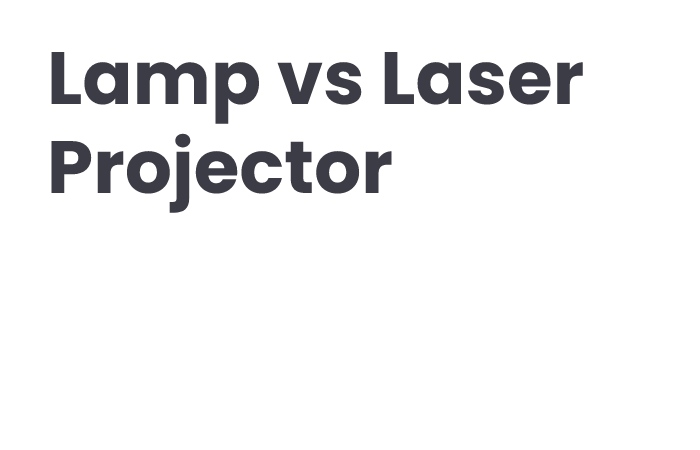Table of Contents
Introduction
Laser Projectors – Today’s technology industry has gained a reputation for developing new technology just another excuse to raise prices. There is some concern that projector manufacturers have taken this angle by dropping the laser. But we don’t think so.
It’s not for everyone, but laser projectors have some big advantages over older LED technology. We’ve looked at the differences between lamps and laser technology to bring you the top three reasons why you should believe the hype.
Laser Projectors – What Are They and Are They Any Good?
1. Improve Color and Brightness
Let’s start with image quality. The main visual advantage of laser projection is that laser light sources provide better color accuracy. Often referred to as a wider color gamut. In addition to color, laser projectors provide better brightness uniformity. And also lower brightness degradation over the life of the projector versus their projector counterparts.
Additionally, the laser light source is more controllable which means that laser projectors often display higher contrast than lamp-based projectors.
Some people focus on brightness as one of the benefits of laser projectors, but we think it’s not just about producing more light. Laser projectors produce a better quality of light. The light emitted by a normal lamp-powered projector is not focused and scattered. Imagine shining a torch on a wall – the closer you get to the wall, the more focused, brighter and brighter the light becomes. The laser can create sharp focus sharpness no matter the distance.
At the upper end of the laser projection, some models also have three separate light sources, red, green, and blue, meaning that the unit produces the color you need.
2. Low Maintenance Cost
For many people, the main obstacle to investing in a laser projector is that it is definitely an increase in cost when it comes to the initial outlay. But we consider it a long-term investment. There are regular maintenance costs for lamp projectors and of course the cost of replacing lamps that really starts to increase when you look at lifetime cost of ownership.
On the other hand, laser projectors require little or no maintenance. These light sources have an average life of 20,000 hours, with no bulb replacement, or any other part of the setup required. In comparison, projector bulbs will typically last between 3,000 and 6,000 hours. Based on the lower end of this estimate and you’re looking at 20,000 lamp changes over 7 hours. In some cases where the operating environment is not ideal (dust, heat or humidity), bulbs may fail even under this rating and replacement bulbs themselves do not carry a comprehensive warranty.
3. More Efficient Operation
Our last big gain for laser projectors is their efficiency. It’s not just about reducing energy use; It also provides practical benefits. The lamp projector takes some time to reach its optimum operating temperature because it is essentially heating up. On the other hand, the laser will start to move at the touch of a button.
This may not seem like much of a difference, but the precious minutes you spend here and there waiting for the projector to heat up eventually add up. For your business, downtime is ineffective – and in a hall or presentation, sometimes it’s not even an option. Many laser projectors also have flexible brightness adjustments, so you can save money by calling them in dark environments as well.
Also Read: Equity – Introduction, Importance, Types, and More
Laser Projectors – What else Affects the Brightness of the Displayed Image?
It is improvements in technology that have made it possible to use projectors even in a really bright office. Also with high brightness desktop projectors now available all over the market. But there are a few other things that can help create a brighter image.
Laser Projectors – Screen Gain
Screen gain refers to how much the projector screen’s surface is reflected off. While measuring the raw brightness of an instrument is all well and good, if only a certain amount of that brightness will be reflected back at you, your conferences and meetings will be very effective. Making sure you get a high-gain screen is an important part of getting the best brightness for your money.
Laser Projectors – Throw Distance
It only shows the distance between the projector and the screen. Projectors will have different “throw distances,” meaning that their lenses will produce an image of a certain size from a certain distance. When you project a smaller image, the projector is closer to the screen so the image naturally looks brighter. Finding the right balance between projection distance and image size in bright environments can be challenging. Although developments at the upper end of the market such as lasers and projectors with interchangeable lens options mean that it certainly isn’t the only factor to consider.
Also Read: Trade Execution – Introduction, Methods, Take Away, and More
Lamp vs Laser Projector

Many brands offer a variety of projector models that include LEDs or lasers as the light source. Lamp-based projectors often do not last long, but do provide an affordable and familiar option for consumers, but laser models can excel in brightness and projection life. Leading laser focus projectors do not contain mercury, while lamp models do. Additionally, the technology the lights use can play a key factor in the device’s performance, as well as the projection ratio you’ll find on many ultra-short-throw projectors. To learn more about these technologies, see our articles covering DLP vs. LED Projectors and Laser vs. LED Projectors.
How does a Laser Projector Work?
As the name suggests, laser projectors use laser light to produce the projected image. These devices provide long-lasting light sources using semiconductor lasers. The laser passes through the color wheel inside the projector, then bounces off the mirrors inside the device to produce an image on the projector screen. Unfortunately, this technique sometimes suffers from the rainbow effect caused by the delay in adjusting the color wheel of the spinning wheel. Due to its exceptional brightness, a laser projector should be considered when you want a projector versus an external TV.
Also Read: Revenue Projections – Introduction, Techniques, and More
Flashlight vs Laser Comparison
Brightness: A laser projector gives over 3,500 ANSI lumens, while a lamp-based device gives out over 2,000 ANSI lumens. Due to the essential brightness of the laser, laser products can be used in places with bright ambient light. And also, it will be difficult to see the same image created with the lamp.
Cost: Laser projectors initially cost more than LED-based projectors, but the cost should decrease as these devices continue to proliferate. Currently, the least expensive lamp models are of the three available light sources. However, bulbs often need to be replaced quickly, so you may end up with a similar cost in the long run.
Life: LEDs have an average life of 10,000 hours when operating in eco mode, and the laser version doubles this life by 20,000 hours in eco mode. It is important to note that the light source may not last long when turned on in normal or standard mode.
Size: Lasers are generally larger than lamp models. As a result, laser projectors can be difficult to move. So they are traditionally used in companies or schools in one location. Although smaller than laser projectors, lamp-based models tend to be larger than LED models.
Noise: Both laser and lamp products use a rotating color wheel that is tuned thousands of times per second, so that both make noise. However, you can see that laser models are higher than lamp projectors and both are higher than LED versions. In this case, you need to weigh the effect of noise against the other benefits of lamps and laser projectors.
Also Read: Welfare Economy – Introduction, Goals, Features, and More
Conclusion
The solid-state lasers used in today’s projectors are extremely bright, have a wide color space, deep black levels and never require a lamp change! Yes, replacement bulbs are becoming less expensive, but there is labor to replace these bulbs. For example, if the projector is install upstairs in a secure location, you may need to rent an elevator. Do this 3 or 4 times and you’re not moving forward with the savings.
In addition, these laser light source projectors are a particularly good choice for heavy use and “all-day” applications. Because they do not get as hot as traditional projectors. And unlike lamp-based projection, its white color and brightness are maintain for a very long time. They also offer greater installation flexibility – some can be placed at any point in a 360-degree radius.
Also Read: Steampunk keyboard – Introduction, Steampunk keyboard
Related posts
Featured Posts
S/4HANA Services: Complete Guide
Introduction: The world of technology does not stand still. Business must continue to keep track. Business needs more effective management…
Megakino .com: Your Ultimate Guide to Free Movie Streaming
In the digital age, streaming pictures and television shows have become the go-to entertainment option for millions worldwide. Choosing a…


